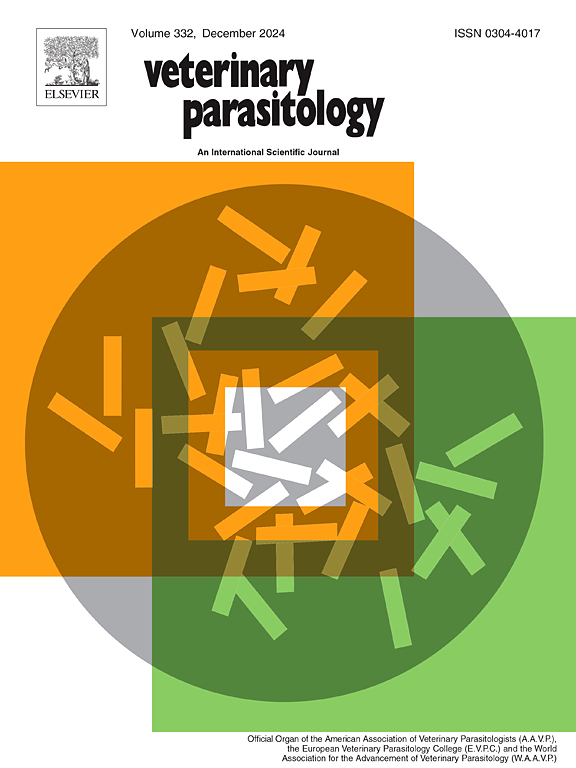从选择到抗性:在药物压力下钩虫进化的线粒体发现
IF 2
2区 农林科学
Q2 PARASITOLOGY
引用次数: 0
摘要
线虫β-微管蛋白同型基因的密码子134、167、198和200的单核苷酸多态性与苯并咪唑耐药性有关。本课课组此前通过药物诱导的选择压力,从实验室条件下维持超过15年的野生型菌株中,筛选出了一株对阿苯达唑耐药的蓝钩虫菌株。这项研究的目的是研究线粒体遗传变异的抗性菌株相比,其野生型对应物。在选择过程中和选择后42个月收集的这两种菌株的151只蠕虫,分析了线粒体COI和NAD1基因的部分序列。抗性菌株中仅检测到核苷酸变异,COI和NAD1的差异水平较低,分别为0.16 %(1/612 bp)和0.25 %(1/398 bp)。所有的COI替换都是同义的,而NAD1出现了一个非同义突变。基于极大似然和贝叶斯推理的系统发育分析显示,抗性和野生型实验室样本之间存在强聚类(COI: 99 % bootstrap;NAD1: 96 %),不同于字段衍生序列。这些发现表明,由于隔离和基因流动受限而产生的遗传同质种群可能更容易受到遗传压力(包括选择)的影响,从而可能导致抗性寄生虫的形成。本研究强调了群体遗传学在耐药性进化中的作用,并强调了管理遗传多样性以减轻耐药性发展的重要性。本文章由计算机程序翻译,如有差异,请以英文原文为准。
From selection to resistance: Mitochondrial findings in hookworm evolution under drug pressure
Single nucleotide polymorphisms (SNPs) in codons 134, 167, 198, and 200 of the β-tubulin isotype 1 gene are associated with benzimidazole resistance in nematodes. Our group previously selected an Ancylostoma ceylanicum strain resistant to albendazole through drug-induced selective pressure, derived from a wild-type strain maintained under laboratory conditions for over 15 years. This study aimed to investigate mitochondrial genetic variability in the resistant strain compared to its wild-type counterpart. A total of 151 worms from both strains, collected during and 42 months after the selection process, were analyzed for partial sequences of the mitochondrial COI and NAD1 genes. Nucleotide variations were detected exclusively in the resistant strain, with low divergence levels of 0.16 % (1/612 bp) in COI and 0.25 % (1/398 bp) in NAD1. All COI substitutions were synonymous, while NAD1 presented one nonsynonymous mutation. Phylogenetic analyses based on Maximum Likelihood and Bayesian inference revealed strong clustering between resistant and wild-type laboratory samples (COI: 99 % bootstrap; NAD1: 96 %), distinct from field-derived sequences. These findings suggest that genetically homogeneous populations, resulting from isolation and restricted gene flow, may be more susceptible to genetic pressures, including selection, potentially leading to the establishment of resistant parasites. This study underscores the role of population genetics in the evolution of drug resistance and emphasizes the importance of managing genetic diversity to mitigate resistance development.
求助全文
通过发布文献求助,成功后即可免费获取论文全文。
去求助
来源期刊

Veterinary parasitology
农林科学-寄生虫学
CiteScore
5.30
自引率
7.70%
发文量
126
审稿时长
36 days
期刊介绍:
The journal Veterinary Parasitology has an open access mirror journal,Veterinary Parasitology: X, sharing the same aims and scope, editorial team, submission system and rigorous peer review.
This journal is concerned with those aspects of helminthology, protozoology and entomology which are of interest to animal health investigators, veterinary practitioners and others with a special interest in parasitology. Papers of the highest quality dealing with all aspects of disease prevention, pathology, treatment, epidemiology, and control of parasites in all domesticated animals, fall within the scope of the journal. Papers of geographically limited (local) interest which are not of interest to an international audience will not be accepted. Authors who submit papers based on local data will need to indicate why their paper is relevant to a broader readership.
Parasitological studies on laboratory animals fall within the scope of the journal only if they provide a reasonably close model of a disease of domestic animals. Additionally the journal will consider papers relating to wildlife species where they may act as disease reservoirs to domestic animals, or as a zoonotic reservoir. Case studies considered to be unique or of specific interest to the journal, will also be considered on occasions at the Editors'' discretion. Papers dealing exclusively with the taxonomy of parasites do not fall within the scope of the journal.
 求助内容:
求助内容: 应助结果提醒方式:
应助结果提醒方式:


